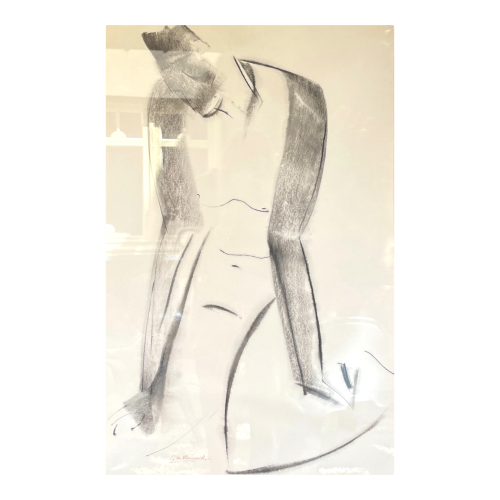GEORGES (dit Géo) DE VLAMYNCK, tableau / pienture technique mixte sur papier, craie et fusain sur papier mouillé, milieu du 20ème siècle.
Le peintre représente ici un corps de femme nue de manière minimaliste, quelques traits suffisent à croquer l'instant, à la recherche de l'abstraction, non sans rappeler certain dessins de nus de Henri Matisse à cette même époque.
Parfait état (difficile à photographier avec la vitre de protection).
Dimensions totales, avec encadrement et passe-partout en tissus : 97,5 cm x 67,5 cm.
- Artiste / Designer:Georges De Vlamynck (1897-1980).
- Signature / Monogramme:Signé "G. De Vlamynck".
- Période:20ème siècle / Mid Century
- Pays d'Origine:Belgique.
- Dimensions (H x L x P):75 x 48 x 2 cm.
- Poids:3 Kg.
- Etat:Excellent, encadrement Schleiper.
- Style:Art Déco / Art Modern / Abstraction.
- Matières:Technique Mixte / Fusain / Craie mouillée.
-
Price:2200€
- Pick-up:Free.
- Belgium Delivery:50€.
- France Delivery:100€.
- Europe Delivery:150€.
- Worldwide Delivery:On request.
Provenance: Studio of the artist Lola Di Vito, mezzo soprano singer, painter and sculptor. She was a pupil (and most certainly a muse, as sketched in this painting) of Géo De Vlamynck.
Link to the official website of Géo De Vlamynck: https://www.geodevlamynck.com
Biography: Géo De Vlamynck, born in Bruges in 1897 and died in Koekelberg (Brussels) in 1980, was a painter, fresco artist, stained-glass cartonnier, interior designer and teacher. His pupils included Nicolas de Staël, Maurice Wyckaert and Roger Somville.
In 1909, Georges De Vlamynck attended the Academy of Fine Arts in Bruges, where he was noticed by Flori Van Acker (1858-1940), painter and director of the Academy. During the First World War, he took drawing classes at the Slade School of Fine Art in London. He won first prize with distinction in drawing and perspective.
In 1919, he enrolled at the Académie des Beaux-Arts in Brussels, where he attended classes in decorative painting and composition given by Constant Montald, Herman Richir and Jean Delville. In 1921, he won first prize for monumental composition for ‘Repentir après la Faute’.
In 1922, he won first prize with the highest distinction for ‘Le Renouveau des siècles’.
In 1923, he travelled to Italy where he studied frescoes and mosaics.
In 1927, he continued his training at the Institut d'Architecture et des Arts Décoratifs de la Cambre, founded by Henry Van de Velde. He attended the decorative and monumental painting workshops supervised by Gustave Van de Woestijne and the theatre classes of Herman Teirlinck (a Belgian playwright), for whom he created several sets and show posters.
In 1929, he graduated from La Cambre in painting with distinction. In 1930, he took part in the Universal Exhibition in Liège and Antwerp.
In 1933, he produced stained glass windows for the religious art pavilion at the Chicago Universal Exhibition and executed a fresco and stained glass windows for Cordemoy Abbey, as well as stained glass windows for the Carmelite monastery in Jambes and the church of Saint-Symphorien.
In 1935, he took part in the Universal Exhibition in Brussels. He created several monumental frescoes for the Art Glass pavilion with his pupil Nicolas De Staël, the Agriculture and Gas pavilions and the Maris Stella Chapel.
In 1937, he designed stained glass windows for the Belgian Congo pavilion in Paris. Alongside his career as an artist, he taught at the Académie de Saint-Gilles, at the Bischoffsheim school (decoration section) and at the Académie royale des beaux-arts de Bruxelles in monumental composition.
From 1950 to 1965, he won several competitions to decorate public buildings and went on to create large-scale monumental decorations.
In 1953, he created the monumental mosaic (15 m x 2.70 m) ‘les Naïades’ at the Neptunium swimming pool in Schaerbeek.
In 1956, he painted the mural for the ‘Prehistory’ section of the Royal Museum of Art and History.
In 1957, he created a terracotta mosaic for the Royal Athénée in Welkenraedt, as well as murals for the Salzinnes swimming pool in Namur, which was destroyed in 1921.
In 1962, he created a stained-glass window for the Chapelle de la vierge at the Basilique du Sacré-Cœur in Koekelberg.
Alongside his career as a muralist and teacher, he also painted and drew smaller works.
Sources: / https://www.geodevlamynck.com / https://fr.wikipedia.org/wiki/Géo_De_Vlamynck
Packaging and delivery charges apply:
Collection: Free.
Delivery in Belgium: €50.
Delivery in France: €100.
Delivery in Europe: 150€.
Worldwide delivery: On request.
